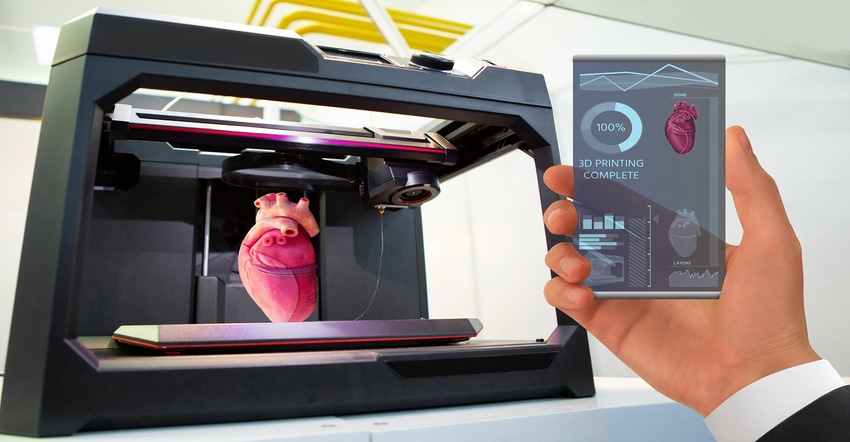A panel on distributed manufacturing at the MedTech conference in Minneapolis looked at using 3D printing to bring medical production closer to users.
November 7, 2022

At the Advanced Manufacturing conference in Minneapolis, the panel Collaboration and Distributed Manufacturing looked at the issue of decentralizing production in medical manufacturing. This would mean taking production to individual healthcare facilities. Panelists agreed that advances in 3D printing offer an opportunity to produce products close to patients. The panelists noted this trend bucks the traditional centralized production model.
Some of the panelists view distributed manufacturing as an efficient way to deliver products, particularly items that are designed to uniquely fit an individual patient. Others noted that the business model may not favor on-the-spot manufacturing.
Yet advances in digital processes and 3D printing make distributed manufacturing seem more achievable than ever. The panel looked at how device manufacturers might work with hospitals to make patient-specific devices more readily available. The biggest hang-up seems to be making the business model work.
The panel included an impressive line-up:
Beth Ripley, MD Ph.D., director, VHA 3D Printing Network at the US Department of Veterans Affairs
Ted Anderson, industrialization leader at GE Additive
John Wilczynski, executive director at America Makes at the National Center for Defense Manufacturing and Machining
Alain Fortuney, director of 3D Printing Delivery & Digital Ecosystem at Johnson & Johnson
The Implicit Need for Distributed Manufacturing
The Veteran’s Administration may be a good test case for producing one-off medical products designed for individual patients. “We have nine million vets who could walk into any VA facility needing to receive a 3D printed prosthetic,” said Beth Ripley, MD Ph.D., director, VHA 3D Printing Network at the US Department of Veterans Affairs. “That’s been difficult in the past with centralized production. That’s a process that has to move to distributed production going forward.”
Johnson & Johnson is a major traditional medical manufacturer that is looking at the possibility of distributed production. “We’re working on personalization. 3D printing overcame the constraints of the supply chain during the pandemic,” said Alain Fortuney, director of 3D Printing Delivery & Digital Ecosystem at Johnson & Johnson. “It showed us ways of overcoming protectionism. It showed us an opportunity to become more resilient.”
One of the biggest challenges is overcoming traditional thinking that favors centralized manufacturing. One alternative might include turning to outside companies. “We’re trying to decentralize. We want people with knowledge decentralized, but it’s not easy,” said Ted Anderson, industrialization leader at GE Additive. “We’re looking at third-party companies since they’re not bureaucratic. It’s the same with every industry. You have to find an efficient model.”
Blocks to On-site Production
A tradition of centralized manufacturing can impede moves toward a distributed production model. “We see the opportunity of making products locally or regionally,” said Fortuney. “But right now we’re centrally located. We’re looking at some hybrid models of distributed manufacturing at healthcare facilities. We see that will eventually happen even though we’re a traditional manufacturer.”
Another barrier to distributed production is simply the matter of getting the model to scale in a way that makes economic sense. “It makes sense to have production close to the user,” said Ripley. “What we’re trying to achieve is access spread across our facilities. The challenge is how it scales.”
Yet another barrier is the need for a shift in the way a company looks at its manufacturing processes. “We look at manufacturing’s capability at the point of care,” said Anderson. “It’s not an easy paradigm shift. You have to figure out how to handle metal and metal powder.”
Possible Paths Forward
One industry – dental – has been successful at moving most of its production to local 3D printing companies. Some dental practices have set up 3D printers in the dental office itself. “Dental shows what the future can be. We have to look at the secret sauce in dental,” said Fortuney.
Overcoming resistance to change is another major factor in moving to a distributed model. “People get scared of new technology. They want to do more testing,” said Anderson. “With 3D printing, they want to do more testing than they do with other technologies.”
Yet distributed production may be inevitable simply because it’s a clear improvement over the centralized model when it comes to patient care. “It’s going to become essential,” said Ripley. “But you have to be able to repeat what you’re doing at each site. The capabilities of the digital twin will help going forward. This will drive constant improvement.”
Ripley also noted there is high motivation to make the distributed manufacturing model work. “The passion behind this is the need to treat the patient better.”
About the Author(s)
You May Also Like



